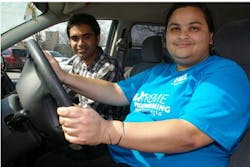Vision system helps curb drunken drivers
Drunk driving may soon become a thing of the past thanks to a face-recognition program developed by a pair of University of Windsor (Windsor, Ontario, Canada) engineering graduate students.
The Driver ID system they have developed would work in conjunction with technology that could be incorporated into steering wheels to detect the level of alcohol in a driver’s blood, according to John Carroll, chief technology officer at Waterloo-based Sober Steering (Waterloo, Ontario, Canada).
“It’s a pre-prototype and still very much a proof of concept,” says Carroll, whose company was one of seven small to medium-sized businesses to receive funding in 2010 from the FedDev Applied Research and Commercialization Initiative to work with the University of Windsor researchers on turning their ideas into commercially viable products.
Carroll’s company has developed technology which would see transdermal sensors built into a steering wheel that would detect a driver’s blood alcohol level when they placed their hands on the wheel by analyzing the gas coming from their palms. If their level exceeded a pre-set limit, the individual would not be allowed to drive the car. The company is currently in the process of developing the technology, with the goal of making it available for manufacturers to build into their vehicles.
However, the company needed to address the problem of what to do if an intoxicated individual attempted to fool the system by getting a sober person to sit in the driver’s seat, put their hands on the wheel and try to start the vehicle.
To help out, PhD student Ashirbani Saha and Master’s student Kaushik Ray developed an algorithm for a face recognition system that would work in concert with the sober steering sensors to authenticate the identity of the driver.
Using the system, only authorized individuals with permissible blood-alcohol levels would be allowed to drive the car and its owner would have ultimate control over who is permitted to drive it. To do so, a small, infrared camera mounted in the vehicle would capture an image of the person behind the wheel and compare it to images stored in a database. The system could also check periodically to verify who is driving.
“If the person is not in the database, they will not be allowed to drive the car, so in that way, it will also help prevent auto theft,” says Ray.
-- by Dave Wilson, Senior Editor, Vision Systems Design
